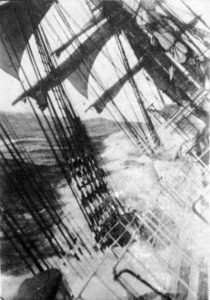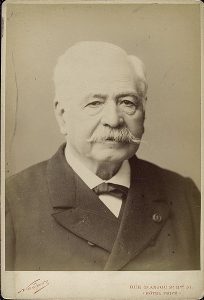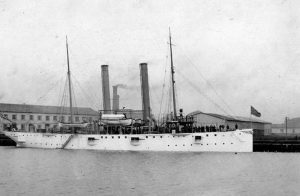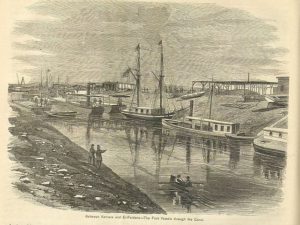
Circa 1854-1954 (no exact date exists)
Source: National Library of Australia
Public Domain via Wikimedia Commons
For hundreds of years sailors who made the long trek from Europe to the Pacific Ocean had a dream. A dream of one day being able to sail straight across rather than all the way down to the tip of South America where the Atlantic and Pacific Oceans meet. Cape Horn, so named by a Dutch captain in 1615, was a major point shipping point where trade ships plied between Europe and Asia. If you wanted to get to China, Japan, or shipping ports on the Pacific western coast (South America up to Alaska), this was the preferred route for many merchant and military vessels. However, the convergence of both oceans at that area also led to it being a treacherous path at times due to fierce storms that really put the skills of a mariner to a test. Many a ship has sunk in those waters and many explorers saw their fleets thinned out in that area.
The building of the transatlantic railway helped reduce the need to ship freight and passengers somewhat but not enough. A land route through the Isthmus of Panama was possible though it had its own perils as well. You had to walk from the one coast to the other through a jungle. The Spanish established Panama on the Pacific and the Nombre de Dios on the Atlantic connected by 49 mile (80 km) simple jungle path. The path was simple and not built for moving cargo but moving people (mostly soldiers) from one coast to the other. People who choose this route over taking a ship faced a hot climate, insects that carried malaria, and other surprises that were not for the faint of heart. A railroad was constructed (at heavy cost) to move people and freight but that still left ships making the dangerous route. Hence the dream of a canal was born. Building it was another matter.
The French Try and Fail

Public Domain via Wikimedia Commons
After building the Suez Canal in 1869, the French government thought it could do the same in connecting the Atlantic to the Pacific Oceans. Sitting in their comfortable rooms back in France, they perceived no difficulty. Hence the first problem-not fully sending an expedition to completely survey and determine exactly how such a canal would need to be built. In 1876, La Société internationale du Canal interocéanique was created to create the Panama Canal. It obtained an exclusive concession from the Colombian government to build the canal in Panama. The concession was to last for 15 years and then the canal would revert to Columbia. Ferdinand de Lesseps, who had headed up the Suez Canal project, was put in charge. Having his name attached made it easier to attract investors to the company. Lesseps though, was not an engineer and did not fully comprehend how much different it would be to build this canal. A canal through the desert was easy to what they found in Panama.
In order to make a canal feasible, you had to have a way to accommodate the fact that its lowest level, it would still be 360 feat above sea level at the lowest crossing point. Lesseps initially proposed a sea level canal but it would require enormous excavation of rock. And the rock was not very stable either. And then there was the problem of the rivers that would cross the canal creating in certain times of the year creating currents that would danger shipping. So the Chagres would have to be diverted to avoid this problem, which added more complexity to an already complex building project. Then there was the problem of tropical diseases of which both malaria and yellow fever were the worst. It was not understood how they were transmitted, but mosquitoes were prevalent and not understand as the transmitter of such diseases.
An international body headed up by Lesseps started in 1879 in Paris. The Congress for Study of an Interoceanic Canal brought together 136 delegates from 26 countries but only 42 were engineers. Others were a variety of people interested in the project and so it was mostly a fundraising event and to make legitimate the Lessep idea was (drawn from plans made by Lucien Bonaparte-Wyse and Armand Réclus) of a sea level canal that would be as easy to complete as the Suez Canal. Ultimately only 19 engineers would approve the plan but except for one, had never been to Central America. It was originally projected to cost $214 million, then revised down to $168 million. For reasons never explained, Lesseps reduced the estimate twice down to $120 million and that it would take six years to build.
Oops, we need to start over!
Construction began on 1 January 1881 with digging at Culebra on 22 January. A huge labor force was needed and a lot of them came from African-Caribbean workers from the West Indies. There was no shortage of experienced engineers needed but, as in the case of the workers, disease made it hard to retain them. And once word got out that the fever canal was not a good place to work in, it became harder to find engineers willing to put their health at risk. The death toll from 1881-1889 is estimated to be over 22.000 but is likely higher.
Then in 1885 another shock hit. The sea level canal was not possible to build owing to the fact that there was no way to remedy the elevation difference between where the lowest point is still 360 feet above sea level. It became obvious that only a lock canal plan would work. Lesseps was not convinced but ultimately engineering studies proved it was the only practical way to achieve this. It was finally adopted in 1887 but the scandal caused by the engineering problems, financial problems, the mortality rates rising, and worse frequent floods and mudslides indicated this project was in peril. While work on the new plan continued, it would end on 15 May 1889 when the company went bankrupt. The canal was about two-fifths done and over $234 million had been spent.
And it got worse back in France where investigations into how this ended so badly. An official commission was ordered by the French parliament. Worse were some were blaming Jews who speculated on the project. Despite all of this, the French government decided to keep it going, if nothing else to recoup expenses and show the world it could complete the canal. A new company was formed to finish the canal (Compagnie Nouvelle du Canal de Panama). A new concession was obtained from Colombia and work started up again this time with the plan of a two level, lock based canal. However, they ran into a wholly different problem than before as the United States was getting involved and was going to build a canal through Nicaragua instead. This made the French canal through Panama useless, and the company started looking for a buyer with deep pockets. And they found one. The United States bought it up and a whole new ballgame had begun.
The U.S. Builds the Canal
The French had negotiated a concession with the Columbian government, but the U.S. found it difficult. The U.S. bought the French company and land. A treaty was signed in 1903 (Hay-Herran Treaty) that gave the U.S. the rights to build in Panama. Unfortunately, the Colombia senate did not ratify the treaty. This left the U.S. with a company and land in Panama but no rights to build the canal. Now the area in Panama was inhabited by native people who had tried in the past to gain independence from Columbia but not able to pull it off. An early attempt to recognize Panama independence in 1903 was rejected by Columbia. U.S. President Theodore Roosevelt made it known that if the natives did seek independence, the U.S. would support it.

Public Domain via Wikimedia Commons
On 3 November 1903, a revolt took place with the natives proclaiming their independence from Colombia. The USS Nashville had been stationed there to prevent any Colombian interference. The result was the new Panama government gave the U.S. complete control of the Panama Canal Zone and through a signed treaty gave the new country 10 million, the right of the US to administer and defend the canal and split the fees for canal use.
It was on 4 May 1905, formally called Acquisition Day, the project became official, and construction would commence. It was completed in 1914. The 52-mile canal now connected the Atlantic and Pacific oceans without having to sail down to Cape Horn and into the Pacific. Commercial traffic would increase as more cargo and passenger ships could easily move between the two oceans. The 10-mile Panama Canal Zone would grow and become more important as a result. Today only the supersized ships must make the trip down to Cape Horn as they are too big for the Panama Canal.

Original Source: Historical Atlas” by William R. Shepherd, New York, Henry Holt and Company, 1923
Public Domain via Wikimedia Commons
Today the Panama Canal is recognized as one of the seven wonders of the modern world. In the 1960’s and 1970’s, many Panamanians wanted to revisit the original treaty and gain more control of the canal. In a 1977 treaty signed by President Jimmy Carter and Panama leader Omar Torrijos, it was agreed that the Panama Canal Authority would be turned over to Panama in 1999.
Buy David McCullough’s excellent Path Between The Seas:The Creation of the Panama Canal, 1870-1914
Sources:
Panama Canal: History, Definition & Canal Zone – HISTORY. “Panama Canal: History, Definition and Canal Zone – HISTORY.” HISTORY, 6 Sept. 2022, www.history.com/topics/landmarks/panama-canal.
Worthington, William E., et al. “Panama Canal | Definition, History, Treaty, Map, Locks, and Facts.” Encyclopedia Britannica, 3 May 2024, www.britannica.com/topic/Panama-Canal.
“Isthmus of Panama – on Historic Routes.” On Historic Routes, 27 Mar. 2021, on-historic-routes.com/featured-routes/isthmus-of-panama.
—. “Cape Horn.” Wikipedia, 3 May 2024, en.wikipedia.org/wiki/Cape_Horn#.

